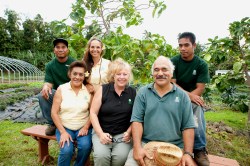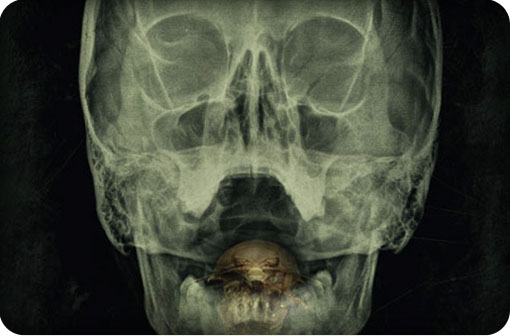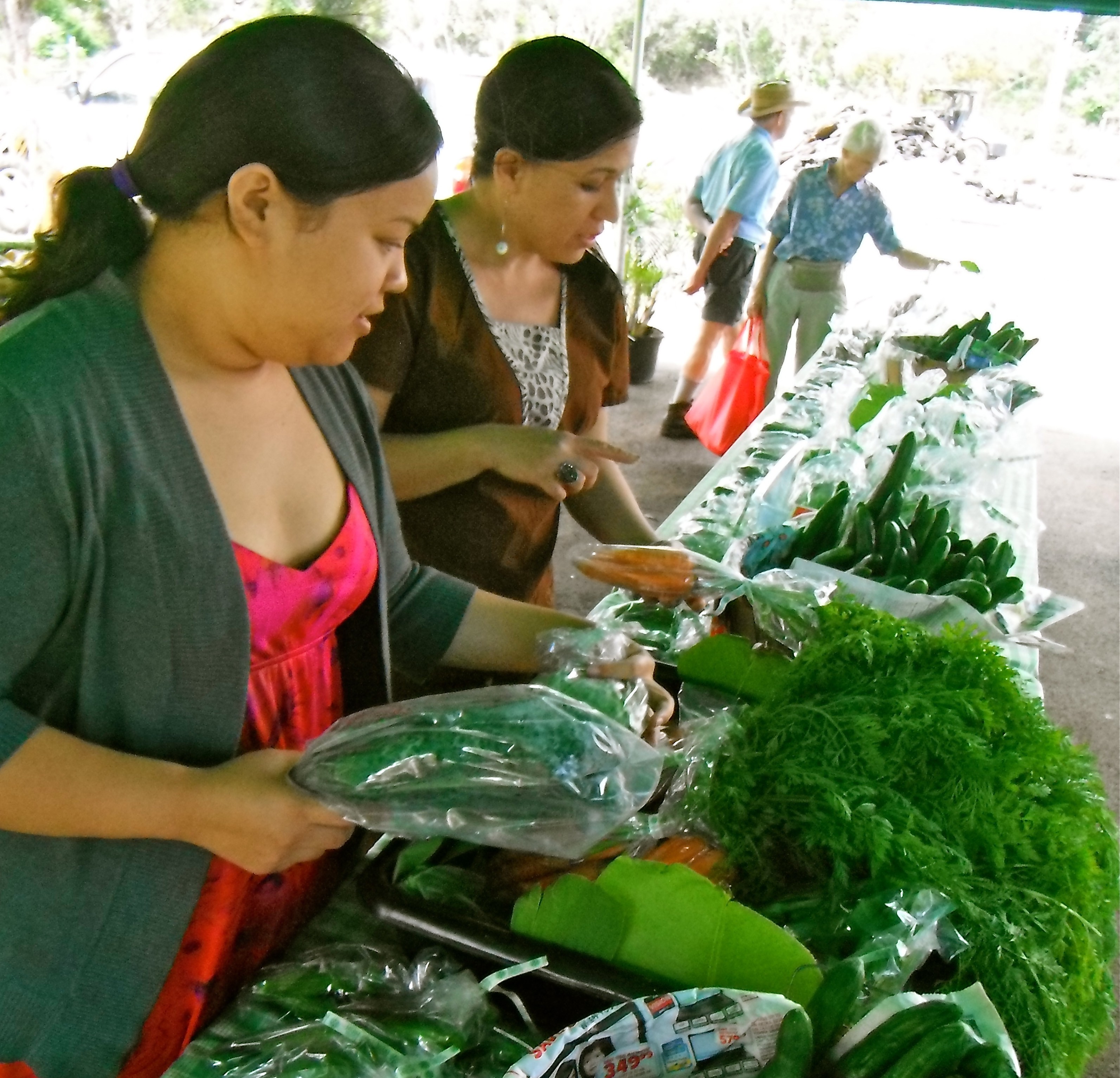
Visitors to the Hana Fresh Farm Market.
Sam Kalalau, a Native Hawaiian who lives in the isolated, rural town of Hana on Maui’s eastern edge, has a dream for his people, many of whom suffer from chronic conditions with dietary links such as obesity, diabetes, and hypertension. Hana is known mostly for its lushness, postcard-perfect beaches, and spectacular oceans views, and less so for its fertile fields. But this produce whisperer helps run Hana Fresh Farm, a seven-acre, certified organic farm situated on a gentle slope and filled with tropical fruit trees, heirloom greens, and fragrant herbs. The 60-year-old also seeks to educate locals and visitors alike about the health benefits of homegrown foods like avocado and papaya over the canned and processed goods transported from the mainland.
Hana Fresh sells freshly picked crops at a roadside stand in front of Hana Health, the squat community wellness center that sits between the popular produce stand and the farm, which also grows gourmet greens and exotic fruits for high-end restaurants, resorts, and grocery stores on the island. Fresh food from the farm is incorporated into the site’s senior meal program. The Hana Fresh Market also sells prepared foods and complete meals in addition to produce and locally sourced fish. Profits from the farm and stand help support the medical facility; last year $60,000 went to fund community health programs, according to the nonprofit’s Executive Director Cheryl Vasconcellos.
For local residents, many of whom are Native Hawaiians, Hana Fresh offers one-stop wellness shopping. “I’d love to see our elders go in for health checkups and come out with a prescription for kale,” says Kalalau. “We’re working on ideas like that now.” He and other staff lead tours of the farm, where visitors can learn about the challenges of growing food in the tropics and traditional Hawaiian medicinal ways.
Most tourists think of Hana — reached by navigating a stunning stretch of “highway” with hundreds of hairpin turns and dozens of one-lane bridges — as a patch of paradise with gorgeous waterfalls, verdant landscapes, and serene swimming holes.

Hana Fresh Farm’s executive director, Cheryl Vasconcellos, is in the front row, center. Farmer Sam Kalalau is sitting on her right.
But people live here too. And the roughly 2,200 residents of this remote area rely on Hana Health and Hana Fresh for routine things most tourists take for granted, like primary medical and mental health care, dental cleanings, and access to nutritious food. Hana is a federally designated underserved area, and the organization’s mission is to provide a safety net and improve the health and wellness of the community, particularly for Native Hawaiians and others who are at risk due to financial, cultural, and geographic barriers. “Many of our patients go straight out the door from their medical appointments to buy vegetables, pick up a salad or smoothie for lunch, or even dinner,” says Mary Hanchett, a medical receptionist who has worked at the clinic for nine years.
The 35-year-old mother of two was born and raised in Hana, and relies on the farm stand as well. Hanchett is healthy, but she keeps close tabs on her blood pressure and cholesterol, since there is a history of these conditions in her family. “I’ve always been careful about what I eat because of my genetic disposition,” she says. “I do enjoy Hawaiian food — like pork — but I also eat a lot of vegetables and the farm and market make that easy for me to do. There was nothing like this when I was growing up here.”
Native Hawaiians like Hanchett are at greater risk for a slew of health conditions: The population is three times more likely to be diagnosed with diabetes compared to white folks, and they face twice the risk of heart disease compared with other ethnic groups. Hawaiians are also 70 percent more likely to have high blood pressure than their white counterparts, according to the U.S. Office of Minority Health.
Preventing such conditions takes education, community outreach, and money. The recently constructed on-site kitchen, the Hana Nutrition Center — which took about 10 years to complete — is key to the program’s continued economic sustainability, as it allows the facility to expand its prepared food line and make value-added products such as preserves and pickles. It will also allow Hana Health to expand its nutrition, meal, and obesity-prevention programs, says Vasconcellos. The organization previously ran its programs out of a 75-year-old, 100-square-foot building.
Hana Health supports healthy lifestyles and hopes to prevent chronic medical conditions on what Vasconcellos calls “a stealth basis.”
“We make sure we have good food that people will want to eat at the market,” she adds. “We don’t ever refer to it as ‘healthy.’ We refer to it as ‘really good.’ And it’s taken off.”
The facility is experimenting with incentives to attract locals to come in for regular checkups. A women’s health initiative will include a “no fee” health exam, pap smear, half-hour traditional lomilomi massage, wapine (lemongrass) ice tea, and a $75 gift certificate for the farmers market. A school-focused effort will give elementary-age students a pedometer, and, upon walking to school two mornings a week, a healthy snack once they get there. Children with the most activity for the week get gift certificates for fresh fruit smoothies at the farm stand.
For the past three years, the medical center has been tracking residents’ fresh produce consumption, and they’ve seen it increase by one serving a day. It’s a modest improvement in diet, which the Hana Fresh staff hope will rise and translate into improved health over the long haul, says Vasconcellos. Anecdotally, she’s seen health benefits in the local population who access the nonprofit’s services. “We know that there is still just one patient receiving dialysis, and this has not changed in several years,” she says, as another indicator of the community’s health.
The farm has operated in earnest since 2006, although prior to that a large on-site garden provided fresh produce for seniors, says Vasconcellos. The stand started in 2007, and moved to a daily market three years ago. The medical facility dates back to the 1940s plantation era, when six sugar companies operated in the area and several thousand people called Hana home.
In addition to her official administrative, financial, personnel, planning, and public relations duties, Vasconcellos can also be found pulling weeds and serving meals. There is no room at the nonprofit for slackers, she says. Running a farm business is rewarding — but it’s also a lot of hard work. There’s some overlap in job descriptions, but the organization employs about 36 people: 17 in the clinic, 14 in the farm and farm stand, and five in the nutrition center.
“On any given day you can find me harvesting carrots, baking banana bread, or washing dishes, depending on what needs to get done at the time,” says Vasconcellos. “It’s the nature of working in Hana. We have to be self-reliant. It’s not for everyone.”
But it’s clear that the work suits Vasconcellos, a resident for 15 years. “Hana Health is on the cutting edge of so many issues,” she says. “It’s exciting, challenging, and often frustrating, but I think we are on to something important and hope that future health indicators bear this out.”
Solving the community’s food supply problem — by growing its own — seems like a good place to start.




